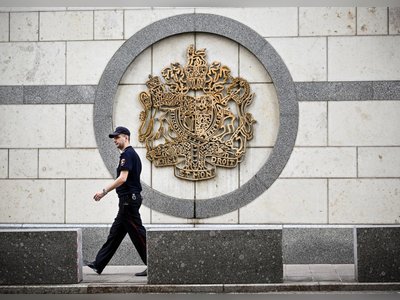
The Coronavirus Is Sending Lots Of Younger People To The Hospital
The coronavirus is severely harming substantial numbers of people under 50, too.
Despite health officials’ pleas to stay home and avoid spreading the coronavirus, young people have been packing beaches and hiking trails, picnicking in parks and brunching in restaurants, and flying to far-flung destinations on the cheap. “At the end of the day, I'm not going to let it stop me from partying,” one Miami spring-breaker infamously told CBS News.
This sense of invincibility has been at least partly rooted in the widespread belief, based on early data out of China, that COVID-19 causes the elderly to suffer the most and spares younger people with milder symptoms.
But as the pandemic ratchets up, with 417,000 cases and counting worldwide as of Tuesday, it’s increasingly clear that the coronavirus is severely harming substantial numbers of people under 50.
In New York City, health officials said Friday that of 1,160 people hospitalized with COVID-19 symptoms, one in four were between ages 18 and 49. That squares with what appears to be happening nationwide: Across the United States, about 38% of coronavirus patients sick enough to be hospitalized were ages 20 to 54, the CDC reported last week.
Young people outside the US have also been severely affected. In Spain, about 18% of hospitalized patients are under 50, according to the latest data. And in South Korea, more than half of confirmed cases are under 50, with the ages 20–29 being the largest age group. (The government doesn’t break down how many of those cases required hospitalization.) Anecdotal data out of the UK, where demographic data on patient ages has yet to be released by the government, also suggests that young people have needed intensive care in hospitals.
It’s still true that the older you are, the more likely you are to be hospitalized or die from the disease. Children under age 10 are the smallest portion of coronavirus patients.
Young people who don’t suffer from severe symptoms can still spread it to others. At the same time, their growing case numbers indicate that they are themselves far from “invincible,” as the World Health Organization director said in a speech directed at them last week. Even if they don’t die in the hospital, they can jeopardize others by taking up beds and ventilators in short supply.
“Even if the deaths are concentrated at older ages, it still seems that serious cases and hospitalization and requiring ventilators is not entirely rare even at younger ages,” Jennifer Dowd, an associate professor of demography and population health at the University of Oxford, told BuzzFeed News. “I would say nobody should just laugh it off as, ‘I’ve got a good immune system and I’ll be fine.’ Because as we get more and more cases, even a small risk of complications adds up to a lot of people.”
And some younger people are dying. So far this week, the coronavirus’s many victims have reportedly included a 36-year-old Brooklyn school principal and an 18-year-old with an underlying health condition in the UK.
In an open letter on Monday, more than 75 health care workers in Miami pleaded for the community to take the virus seriously. “This is not just a problem for the elderly and chronically-ill,” they wrote.
The coronavirus’s spread throughout China, where it originated, provided the broader public with its initial understanding of the virus. The WHO’s February report on nearly 56,000 confirmed cases in China found that “most people” — about 80% — have “mild to moderate disease” and recover. Those at highest risk for severe symptoms and death include people over age 60, as well as those with underlying conditions such as hypertension, diabetes, heart disease, and cancer, according to the report.
“A very small proportion of those aged under 19 years have developed severe (2.5%) or critical disease (0.2%),” the WHO’s report on China’s outbreak stated.
Some people interpreted those findings to mean they were safe.
But “I’m just not sure we can extrapolate from the published Chinese data to what the experience will be like in the USA,” said Andrew Noymer, an associate professor of public health at the University of California at Irvine.
Due to political and cultural differences, China’s total lockdown of tens of millions of people is unlikely to be replicated in Western countries, including the US. China also hasn’t always been transparent about reporting its health statistics, Noymer said. High smoking rates there may have also helped worsened people’s complications from the disease. For those reasons, what happened in China may have been an anomaly.
In a preprint that has not been peer-reviewed, researchers estimated that, in the United Kingdom, about 9% of people under 50 would require hospitalization due to the coronavirus, based on data from China’s outbreak.
Advertisement
But other countries are currently reporting higher percentages than that, and right now, it’s difficult to know why. Each country’s outbreak is influenced by location-specific factors, and each government reports cases a little differently.
Much of the epidemic in South Korea, for instance, was uniquely driven by transmission within a religious sect. The country also implemented widespread testing right away.
Italy has the world’s second-oldest population, which may explain why more than three-fourths of people who have died there were age 70 and above — and why the country has the highest coronavirus death count. The virus may have also been transmitted to older parents by their adult children, who often live with them, as Dowd of the University of Oxford recently wrote in a preprint examining how age factors may have driven the coronavirus outbreak there.
As for the US, testing is weeks behind the curve, creating a vastly incomplete picture of who has the disease.
Some experts and health agencies have speculated that certain lifestyle factors may be playing a role in these cases of younger patients. Vapers and smokers may be especially susceptible, the National Institute on Drug Abuse suggested on its website this month.
But it’s too early to know to what extent those factors are contributing to the outbreak, or if they are unique to the US. American teens are more likely than their European counterparts to vape, but less likely to smoke conventional cigarettes.
“The young people who are showing up and getting tested are those that are quite severe cases,” Dowd said. “It’s probably not actually representative of the true prevalence of serious cases among people in those age groups. It's just those sick enough to show up in the hospitals are the only ones getting measured right now in the US.”
That especially applies to cities like New York, which tend to skew young, Dowd said.
There’s another grim explanation for why older adults are dying in such higher numbers compared to the rest of the population. It might not be because older patients are the only ones with severe cases. Doctors, faced with a perilous shortage of equipment, may be forced to make the heart-wrenching choice to keep younger patients alive instead.
“We’ll see more younger people being saved because these ventilator technologies can save lives, and we’ll see more younger people’s deaths being delayed,” Noymer said.
As more cases surface — more than 53,000 in the US as of Tuesday, upwards of 25,000 of them in New York alone — the gravity of the situation may soon sink in for more young people.
It has, at least, for the high school graduate who days ago said the coronavirus wouldn’t keep him from partying during spring break in Miami.
“Our generation may feel invincible, like I did when I commented,” he wrote on Instagram on Monday. “But we have a responsibility to listen and follow the recommendations in our communities.”
This sense of invincibility has been at least partly rooted in the widespread belief, based on early data out of China, that COVID-19 causes the elderly to suffer the most and spares younger people with milder symptoms.
But as the pandemic ratchets up, with 417,000 cases and counting worldwide as of Tuesday, it’s increasingly clear that the coronavirus is severely harming substantial numbers of people under 50.
In New York City, health officials said Friday that of 1,160 people hospitalized with COVID-19 symptoms, one in four were between ages 18 and 49. That squares with what appears to be happening nationwide: Across the United States, about 38% of coronavirus patients sick enough to be hospitalized were ages 20 to 54, the CDC reported last week.
Young people outside the US have also been severely affected. In Spain, about 18% of hospitalized patients are under 50, according to the latest data. And in South Korea, more than half of confirmed cases are under 50, with the ages 20–29 being the largest age group. (The government doesn’t break down how many of those cases required hospitalization.) Anecdotal data out of the UK, where demographic data on patient ages has yet to be released by the government, also suggests that young people have needed intensive care in hospitals.
It’s still true that the older you are, the more likely you are to be hospitalized or die from the disease. Children under age 10 are the smallest portion of coronavirus patients.
Young people who don’t suffer from severe symptoms can still spread it to others. At the same time, their growing case numbers indicate that they are themselves far from “invincible,” as the World Health Organization director said in a speech directed at them last week. Even if they don’t die in the hospital, they can jeopardize others by taking up beds and ventilators in short supply.
“Even if the deaths are concentrated at older ages, it still seems that serious cases and hospitalization and requiring ventilators is not entirely rare even at younger ages,” Jennifer Dowd, an associate professor of demography and population health at the University of Oxford, told BuzzFeed News. “I would say nobody should just laugh it off as, ‘I’ve got a good immune system and I’ll be fine.’ Because as we get more and more cases, even a small risk of complications adds up to a lot of people.”
And some younger people are dying. So far this week, the coronavirus’s many victims have reportedly included a 36-year-old Brooklyn school principal and an 18-year-old with an underlying health condition in the UK.
In an open letter on Monday, more than 75 health care workers in Miami pleaded for the community to take the virus seriously. “This is not just a problem for the elderly and chronically-ill,” they wrote.
The coronavirus’s spread throughout China, where it originated, provided the broader public with its initial understanding of the virus. The WHO’s February report on nearly 56,000 confirmed cases in China found that “most people” — about 80% — have “mild to moderate disease” and recover. Those at highest risk for severe symptoms and death include people over age 60, as well as those with underlying conditions such as hypertension, diabetes, heart disease, and cancer, according to the report.
“A very small proportion of those aged under 19 years have developed severe (2.5%) or critical disease (0.2%),” the WHO’s report on China’s outbreak stated.
Some people interpreted those findings to mean they were safe.
But “I’m just not sure we can extrapolate from the published Chinese data to what the experience will be like in the USA,” said Andrew Noymer, an associate professor of public health at the University of California at Irvine.
Due to political and cultural differences, China’s total lockdown of tens of millions of people is unlikely to be replicated in Western countries, including the US. China also hasn’t always been transparent about reporting its health statistics, Noymer said. High smoking rates there may have also helped worsened people’s complications from the disease. For those reasons, what happened in China may have been an anomaly.
In a preprint that has not been peer-reviewed, researchers estimated that, in the United Kingdom, about 9% of people under 50 would require hospitalization due to the coronavirus, based on data from China’s outbreak.
Advertisement
But other countries are currently reporting higher percentages than that, and right now, it’s difficult to know why. Each country’s outbreak is influenced by location-specific factors, and each government reports cases a little differently.
Much of the epidemic in South Korea, for instance, was uniquely driven by transmission within a religious sect. The country also implemented widespread testing right away.
Italy has the world’s second-oldest population, which may explain why more than three-fourths of people who have died there were age 70 and above — and why the country has the highest coronavirus death count. The virus may have also been transmitted to older parents by their adult children, who often live with them, as Dowd of the University of Oxford recently wrote in a preprint examining how age factors may have driven the coronavirus outbreak there.
As for the US, testing is weeks behind the curve, creating a vastly incomplete picture of who has the disease.
Some experts and health agencies have speculated that certain lifestyle factors may be playing a role in these cases of younger patients. Vapers and smokers may be especially susceptible, the National Institute on Drug Abuse suggested on its website this month.
But it’s too early to know to what extent those factors are contributing to the outbreak, or if they are unique to the US. American teens are more likely than their European counterparts to vape, but less likely to smoke conventional cigarettes.
“The young people who are showing up and getting tested are those that are quite severe cases,” Dowd said. “It’s probably not actually representative of the true prevalence of serious cases among people in those age groups. It's just those sick enough to show up in the hospitals are the only ones getting measured right now in the US.”
That especially applies to cities like New York, which tend to skew young, Dowd said.
There’s another grim explanation for why older adults are dying in such higher numbers compared to the rest of the population. It might not be because older patients are the only ones with severe cases. Doctors, faced with a perilous shortage of equipment, may be forced to make the heart-wrenching choice to keep younger patients alive instead.
“We’ll see more younger people being saved because these ventilator technologies can save lives, and we’ll see more younger people’s deaths being delayed,” Noymer said.
As more cases surface — more than 53,000 in the US as of Tuesday, upwards of 25,000 of them in New York alone — the gravity of the situation may soon sink in for more young people.
It has, at least, for the high school graduate who days ago said the coronavirus wouldn’t keep him from partying during spring break in Miami.
“Our generation may feel invincible, like I did when I commented,” he wrote on Instagram on Monday. “But we have a responsibility to listen and follow the recommendations in our communities.”










